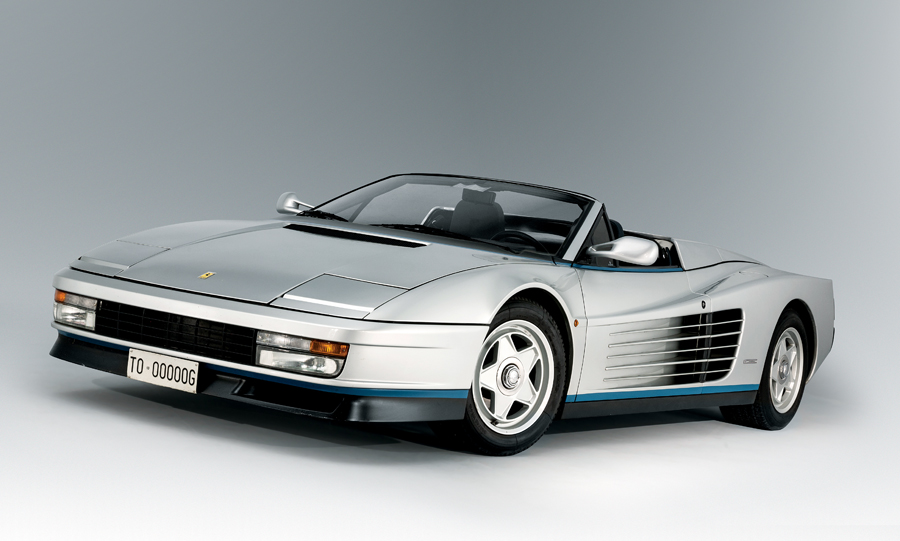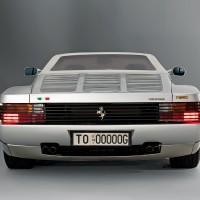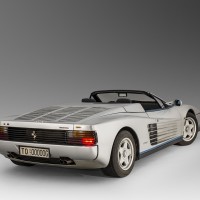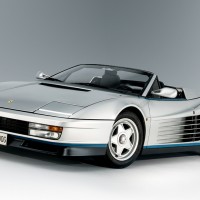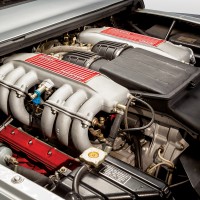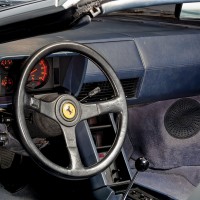SCM Analysis
Detailing
| Vehicle: | 1986 Ferrari Testarossa Spider Valeo |
This car, Lot 116, sold for $1,355,532, including buyer’s premium, at Artcurial’s auction in Paris, FRA, on February 5, 2016.
If you were not there, it is too easy to make fun of the 1980s. While the music and fashion choices of the day were certainly questionable, sports car design and performance made an epic comeback during this memorable decade.
Ferrari and its customers have always coveted their 12-cylinder engines in both racing and street trim. Yet Ferrari did not sell a 12-cylinder car in the United States for over a decade. That would all change in 1984 with the introduction of its new 12-cylinder supercar.
Enter the Testarossa
The Testarossa made its public debut in October 1984 at the Paris Auto Show. Prior to this, Ferrari dealers from throughout the globe were invited to Maranello. Rick Mancuso of Lake Forest Sportscars in Lake Bluff, IL, recalls the emotion and significance of this event.
“We were excited to just meet Enzo in the flesh,” Mancuso said. “We were bused to a walled-off courtyard surrounding a lone covered car. When we saw the Testarossa for the first time, applause, tears and wine flowed. It was an automotive religious experience that I am still reminded of whenever I see a Testarossa.”
The new supercar kept Maranello traditions only when they did not hinder performance or aesthetics.
The first Testarossas still had knockoff wheels (although made in lightweight magnesium) with the odd-sized and dated Michelin TRX tire system.
However, this car was created in a modern wind tunnel for minimal drag and maximum downforce. Pininfarina — rather than Scaglietti — built the bodies. The engines were fitted with high-compression, dry-sump engines with 12 separate injectors. The resulting supercar was the most outrageous and aggressive automotive design since Lamborghini released the Countach.
Gianni Agnelli’s one-off car
What do you buy the richest man in modern Italian history, who owns half of your company and is rather particular about bespoke fashion and flair?
In 1986, Ferrari constructed a beautiful one-off, custom-built spider version of Ferrari’s new masterpiece for Fiat boss Gianni Agnelli.
The car was purposefully not painted in Ferrari red, but in silver, denoting the scientific symbol AG and matching the monogram of its special owner. The rear Ferrari logo was specially cast in real silver.
Agnelli reportedly had a leg injury, which made clutch operation difficult. Ferrari had an answer that may have kicked off a new generation of transmissions.
The beginning of the end of manual gearboxes
Even in 1986, Ferrari may have questioned the future of the standard manual transmission.
For this special car, Maranello employed French clutch specialist Valeo to provide an electro-mechanical actuated system that could engage and disengage the clutch in only 0.02 seconds. Lancia used a similar system in back-to-back World Rally Championships.
Despite its complexity, the street Valeo system has an excellent reputation for reliability. On the Testarossa spider, the driver has the choice of changing gears manually or activating the Valeo electronic clutch system. A Valeo system was later installed on production Mondials — but without a clutch pedal. Several years later, Ferrari built a special F40 with a Valeo transmission for Agnelli.
Better looking than the coupe?
Style is always subjective, but cutting the top off of a subject’s head rarely increases its beauty. This car may be the rare exception.
The spider is better looking than the coupe. The missing roof de-emphasizes the “cheese grater” side panels. An added panel behind the seats is noticeably lower than the front rake, creating the spider silhouette — and distinguishing itself from the Targa tops of the plebeian 328s.
The electric top was not down when SCM’s man on the ground viewed the lot at the Artcurial Auction preview, but photos show the horizontal spinnaker-like assembly neatly fitted under a hinged cover behind the front seats.
According to the September 1987 issue of Road and Track, “a very small, body-colored hard top was fitted when the spider was tested by the factory.” This, however, was not included in the auction sale.
It took the factory four months to complete production of this single automobile. Cost and safety may have been the reasons Maranello never produced a production spider. This created an opportunity for Straman and Pininfarina to produce aftermarket conversions.
Low miles and nearly new
Approximately 23,000 km (14,291 miles) is on the clock. The car’s second owner drove most of those miles.
While there was some chatter that the paint was not 100% original, our on-the-ground SCM analyst conservatively rated the car a 1-. Mr. Agnelli owned the car for just over four-and-a-half years, and it was rumored that the Agnelli family sold the car at a poker game.
While there are obviously no direct comparative sales, it would not have surprised me if this lot had sold for multiples of the final sale price.
What price would you pay for the rarest — and perhaps most beautiful — Testarossa, custom-built for Italian royalty?
Sorry, sir, you missed the boat
Thirty-plus years have passed since the Testarossa’s unveiling. Those who had Testarossa posters as teenagers are now buying the cars of their dreams — just as generations before did with E-types, 356s and Daytonas.
Not long ago, you could have your choice of garden-variety Testarossa coupes (of which they produced over 7,000 during their model run) for under $70k.
Shoulda, coulda, woulda. At RM Sotheby’s February 3, 2016, Paris auction, I reviewed Lot 105, a time-capsule 1989 Testarossa coupe that sold for $210,610.
Of course, should you desire a Ferrari Testarossa Spider Valeo, you will have to make a convincing offer to the new owner of the only one in existence. ♦
(Introductory description courtesy of Artcurial.)
